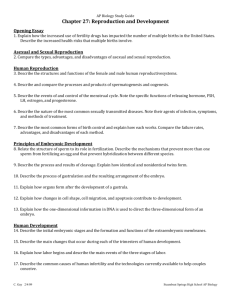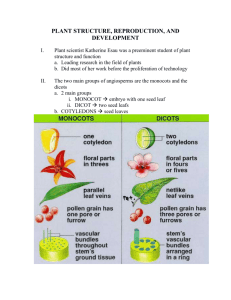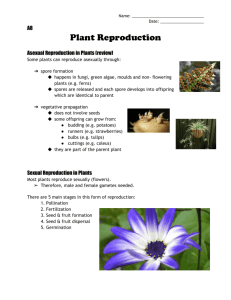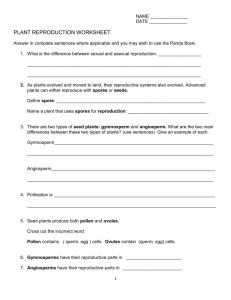Asexual and sexual reproduction
advertisement
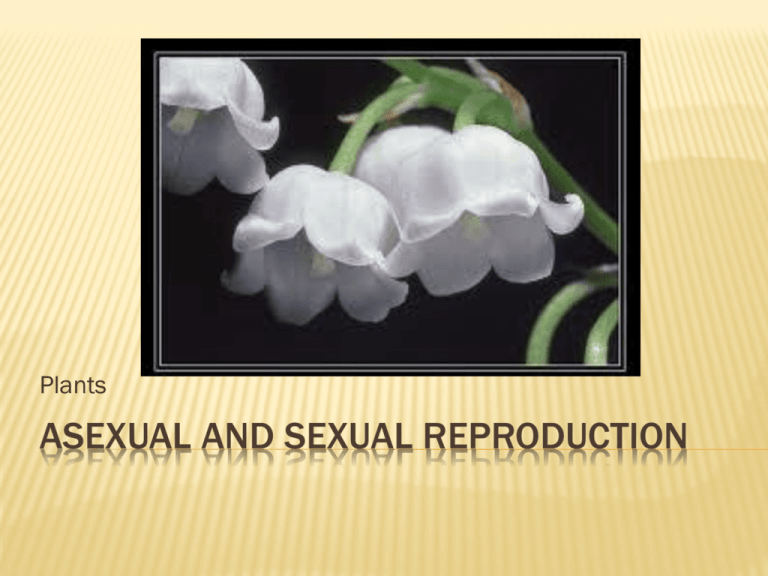
Plants ASEXUAL AND SEXUAL REPRODUCTION PLANTS REPRODUCE BOTH WAYS Asexual reproduction: one living organism involved. Offspring identical to parent. Sexual reproduction: requires one male and one female parent. Offspring different. looks like parents but is genetically DIFFERENT METHODS Conifers and flowering plants: produce cones, flowers and seeds. Algae, mosses and ferns: produce spores. ASEXUAL REPRODUCTION Does not involve meiosis or fertilization. One parent. Used by single-celled organisms such as Archaea, bacteria, and protists. Plants use roots, stems or leaves to reproduce asexually. An advantage of asexual reproduction is that an organism can reproduce by itself and it can occur rapidly. Asexual reproduction can lead to rapid population growth of a species. A disadvantage of asexual reproduction is that only clones are reproduced – there is no genetic variation. An organism would not be able to adapt and evolve to a changing environment. THE TREMBLING ASPEN TREE One forest = one individual TYPES OF ASEXUAL REPRODUCTION Binary fission: one cell divides to form two identical cells. It duplicates its genetic material and then divides. Each new cell has its own complete copy of the parent’s genetic information. Budding: part of the parent develops into a new organism. The new organism then pinches off from the parent and lives independently. The new organism is genetically identical to its parent. Fragmentation: the body of the parent breaks into two distinct pieces, each can produce an offspring. BINARY FISSION, BUDDING, FRAGMENTATION SEXUAL REPRODUCTION Increased genetic diversity of the offspring. Characterized by two processes: Meiosis Fertilization: combination of two gametes (sex cells) During meiosis, chromosomes usually cross over = genetic recombination. Primary method of reproduction for the vast majority of visible organisms, including almost all animals and plants. Plants reproduce sexually: through flowers, cones or seeds. Sexual reproduction has the advantage of providing lots of variation within a species, helping it to survive when the environment changes. The main disadvantage is that this process takes a lot of energy and time. This means that they can only produce small populations. CHERRY BLOSSOM TREE SEEDS A seed contains all the requirements needed to produce a new plant: The embryo: small immature plant The cotyledon: food reserves The seed coat: protective cover TWO TYPES OF SEEDS Gymnosperm (conifer): “naked seed” The seed only has the seed coat to protect it. Angiosperm (flowering plant): “enclosed seed” The seed has the seed coat as well as a second cover (pod, shell or pulp). Pod (beans) Shell (nuts) Pulp (fruits) POD, SHELL AND PULP SEXUAL REPRODUCTION Reproduction in spore-producing plants: No production of seeds! Spores: cells that contain complete genetic material – can become an immature plant without fertilization. Males spores become plants that produce spermatozoa and female spores become plants that produce ovules. Then comes fertilization. Reproduction in conifers: Male cones contain male gametes Female cones contain female gametes Seeds develop in female cones once the ovules are fertilized. Reproduction in flowering plants: Pollination and Fertilization Seed development Seed dispersal SPORES CONES FLOWERS (SEEDS) Flowers can either have male reproductive organs (stamens), female reproduction organs (pistils or carpels) and often a flower has both. Anther: where pollen is produced and stored Filament: supports the anther Pollen: contain male gametes (spermatozoa) Stigma: sticky surface that captures the pollen. Style: supports the stigma Ovary: contains female gametes (ovules) Ovules: female gametes POLLINATION AND FERTILIZATION Pollination leads to fertilization (zygote or fertilized egg). Fertilization: male and female gametes combine. Pollen must land on the stigma in order to fertilize the flower = pollination. Self-pollination: pollen transferred to the pistil of the same flower. Cross-pollination: pollen transferred to the pistil of a different flower through wind or insects. SEED DEVELOPMENT 1st stage of development: spermatozoon (singular of spermatozoa) enters the ovule = fertilization. 2nd stage of development: Cell divides into many cells that specialize themselves into different structures for different functions. SEED DISPERSAL Seed dispersal: main mode or style of dispersing seeds is through fruits. 5 main agents of seed dispersal: Animals, water, wind, the plant itself and humans (sowing seeds). LIFE CYCLE OF THE BEAN Seed, seedling (young plant), adult plant, flower, fruit and back to seed.





